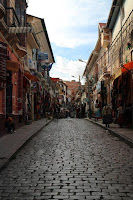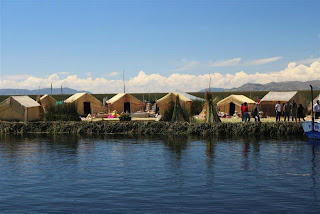 So we´ve left Peru for the time being, and have spent the last few days enjoys the enchanting city of La Paz. La Paz strikes just the right balance between the expected gritty, overcrowded South American city, and a modern cosmopolitan where gourmet ice-creameries are becoming more and more the norm. As one of the largest high altitude cities in the world, you really can´t beat the view. The city is nestled in and around the Altiplano, the Andean Plateau with the impressive snow capped Illimani mountain standing guard over the city. However, before I begin giving you a full run down of Bolivia, I want to fill you in on our last few days in Peru.
So we´ve left Peru for the time being, and have spent the last few days enjoys the enchanting city of La Paz. La Paz strikes just the right balance between the expected gritty, overcrowded South American city, and a modern cosmopolitan where gourmet ice-creameries are becoming more and more the norm. As one of the largest high altitude cities in the world, you really can´t beat the view. The city is nestled in and around the Altiplano, the Andean Plateau with the impressive snow capped Illimani mountain standing guard over the city. However, before I begin giving you a full run down of Bolivia, I want to fill you in on our last few days in Peru.Huacachina
As Dara´s time in Peru was limited (following our visit to Machu Picchu), we decided to fly back to Lima instead of taking the 18 hour bus ride. From there we took a four hour bus to the desert oasis of Huacachina for some rest and relaxation, coupled with some sandboarding. Unfortunately for us (or fortunately depending on how you look at it), we arrived during Semana Santa (Easter Week) and this chilled out, quiet oasis was transformed into a Spring Break Party Town. All the prices were hiked up and accommodation was difficult to come by. We ended up staying in a hostel attached to the only club in the town, which was packed to capacity every night.
 Huacachina was once the playground of the Peruvian elite and the buildings and walkways still hark back to this. These days, however, Huacachina attracts the younger backpacker crowd with sand boarding and sand buggies also close at hand for the adrenaline junkies.
Huacachina was once the playground of the Peruvian elite and the buildings and walkways still hark back to this. These days, however, Huacachina attracts the younger backpacker crowd with sand boarding and sand buggies also close at hand for the adrenaline junkies. Sandboarding is not as easy as it looks, even though Matt and I had been snowboarding a few times. Our friend Ollie who we met on the Jungle Trek to Machu Picchu also joined us in Huacachina. As an avid snowboarder he was the only one of our group who could conquer the sand dunes.
The sand buggie ride was really good fun and pretty scary at times. We would take a run up a vertical sand dune only to reach the top, balance perilously on the edge and then fly almost vertically down the other side.
The views over the sand dunes were spectacular and the sun sets were pretty breath taking. By the Monday the crowds had left and Huacachina regained the chilled out vibe it’s known for. We had a great time but taking on the dunes is not for the faint hearted. I badly twisted my knee sandboarding and Dara escaped with a few bumps and bruises after rocketing down head first down a giant dune on a board. We returned to Lima on Monday night and Dara sadly flew back to the cold of Scotland. Ollie stayed on in Lima before continuing north to Colombia, and we flew to Arequipa before heading to Puno and the beautiful Lake Titicaca.
See more pictures from Peru and Huacachina on Facebook
Lake Titicaca
Puno is the gateway between Peru and Bolivia and is also the largest town on the shores of Lake Titicaca. Lake Titicaca is the largest high altitude lake in the world, sitting at over 3800m above sea level. We were somewhat accustomed to the altitude from Cuzco but still had to take it easy the first day.
Around 2kms from the Puno shore live the Uros people on their fascinating floating islands, made of reeds. They began this existence centuries ago to escape persecution by the Colla and Inca peoples. Today while slightly on the touristy side, the islands and the unique way of life of Uros people is definitely worth seeing.
Each island (there are around 50 in all) is created by lashing large blocks of clay and the roots of reeds together which create a floating platform. On top of this platform they put layers and layers of reeds to make a dry floor on which they build their houses. Three families usually live on each island. The islands are continuously slowly sinking and repairs are made by placing new blocks on top from above. When walking on the island the ground feels slightly springy underfoot and if you pull away even one layer of reeds you can feel the water seeping through from below. For this reason the houses are slightly elevated on a platform of reeds to prevent damp getting into the rooms. The walls, roofs and even the mattresses of the beds are made of reeds as are the traditional boats.
The elaborate traditional reed boats are now mostly used for ceremonies or extracting more money from the tourists by offering a short ride from one island to another (think gondola rides in Venice). Normal wooden row boats or small motor boats are now used from everyday purposes.
Despite the number of tourists visiting the islands, the people still live a very subsistent life. Each island has a solar panel for limited power but apart from that very little has changed. Each island also has a small trout farm in the middle which made fishing a little easier. With the constant need to maintain the islands, the proximity to the mainland and the effect of tourism you can´t help but wonder how much longer the island communities will continue. The climate here is also unforgiving with harsh sunlight and high temperatures during the day and rain and bitter cold temperatures during the night. Without the use of sun cream, everyone bundles up both day and night in thick woolen jumpers and in the case of the women shawls and big frilly elaborate full length skirts.
The landscape is beautiful, but even compared with other areas in Peru, life in Puno and Lake Titicaca seems especially difficult. Everything is still made and carried by hand and even little old ladies struggle down the road carrying ridiculously heavy bundles on their backs. While Lima is modern and cosmopolitan, very little has changed in Puno for centuries or looks likely to change for the foreseeable future. We really enjoyed our trip but did not leave with any romantic, idealistic view of Andean life. Its tough and its cold, and while the women still wear colourful clothes, their lives – as it appeared to us – do not match the vibrant colours.
See more pictures from Puno and Uros Floating Islands on Facebook
See more pictures from Puno and Uros Floating Islands on Facebook











